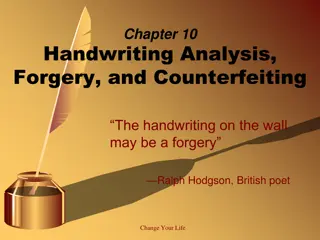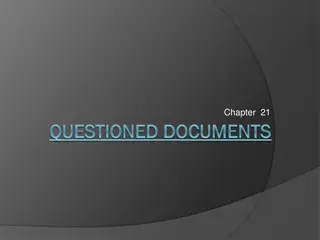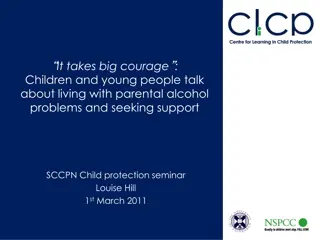Understanding the Development of Handwriting in Children
Handwriting is a crucial developmental process that starts early in children through simple lines and shapes, progressing to forming letters correctly. Teaching pre-handwriting patterns helps children learn the shapes, strokes, and directional skills needed for writing. Sensory perception and hand-finger muscle assessment play essential roles in enabling children to hold a pencil comfortably for extended periods. Correct pencil grip is key for free finger and wrist movement, improving handwriting quality. Various activities and techniques can be employed to develop handwriting skills effectively in children.
Download Presentation

Please find below an Image/Link to download the presentation.
The content on the website is provided AS IS for your information and personal use only. It may not be sold, licensed, or shared on other websites without obtaining consent from the author. Download presentation by click this link. If you encounter any issues during the download, it is possible that the publisher has removed the file from their server.
E N D
Presentation Transcript
Handwriting is a developmental process which starts when children are very young, with simple lines, dots and dashes, often seen as scribble. Learning pre- handwriting patterns is the important first step in handwriting, with children learning the shapes and strokes needed to correctly form letters. As a child develops control of the drawing tool they move from large to small pre-handwriting patterns.
Why Teach Pre-handwriting Patterns? Pre-handwriting patterns help children to learn the shapes and directional pushes and pulls of the writing tools required to form letters. All letters are a combination of these shapes and lines. Young children learn many of these directional pushes, pulls and changes in direction on a much larger scale, long before they pick up a pencil, through playing with cars or pretending to cook. These movements become the drawings/scribbles which young children form once they start mark making, initially as big uncontrolled movements then becoming more controlled and smaller as their gross and fine motor skills develop. These handwriting patterns do not need to be taught as worksheet activities (although they do help to understand, and perfect, how to make the shapes, lines and patterns), drawing pictures and patterns in sand, paint and with other writing tools are all fun ways to practise these patterns.
To hold a pencil comfortably, for extended periods of handwriting, a child needs both good hand and finger muscles and sensory perception. A child might be struggling with handwriting, or be reluctant to write, because they have difficulties with one or both of these.
SENSORY PERCEPTION This relates to the body s ability to send accurate messages to the brain relating to touch and being touched, as well as the movements and position of joints, limbs and muscles. These fine motor skills enable your child to hold a pencil correctly and apply the correct pressure when handwriting. HAND AND FINGER MUSCLE ASSESSMENT This relates to the strength and agility of the hands and fingers so that your child can manipulate, coordinate and have the correct muscle tone for activities such as handwriting and using scissors. These fine motor skills help your child manipulate a pencil and thus form letter shapes.
Pencil Grip Holding the pen or pencil correctly allows the fingers and wrist to move freely, without putting strain on the hand, helping to improve handwriting and making it more comfortable. Watch these three videos to assist with teaching the correct pencil grip with children. VideoVideo2 Video3
Correcting the pencil grip Ways of Correcting a Poor Pencil Grip Place colour markers on the shaft of the pencil to show where to place the thumb and index finger when a tripod grip is used. For left handed writers these should be placed further up the shaft than for a right handed writer. With older children, who will understand, explain why it is important for them to change their pencil grip and how it will help them to improve the quality and quantity of their handwriting and be less tiring as the hand and fingers can move more freely. Understanding how and why can be very powerful incentive for many children, especially if it makes sense to them and you can prove your point. Try using a triangular shaped pencil, especially good for those just learning to handwrite, but watch the middle finger as it can sneak on top of the shaft rather than underneath.
Focus on one point at a time, for example, keeping the little finger and the ring finger gently curled in (try placing a cotton wool ball in the palm of the hand and having the child hold it in place with the little and ring finger). Then focus on the thumb position and index finger, finally the middle finger (a special padded sticker placed on the shaft of the pencil that rests on the middle finger can help). Moulded pencil grip aids can be useful for some children, improving handwriting and building confidence. However an issue with them is that once removed the child reverts back to the original poor grip because the underlining factors of the poor grip position have not been addressed. So use the grips to build self-esteem while building up the key strengths areas that may have caused the poor grip to develop in the first place. The long term aim is to correct the grip so that your child can use any writing tool effectively without the need for some form of grip aid. Coordination, finger and hand strength are important key strengths in being able to hold a pencil correctly for periods of time, so games and activities that help to develop these areas are very useful. Correcting a poor pencil grip will take time, constant encouragement, praise and patients. The long term aim is to correct the grip so that your child can use any writing tool effectively and with confidence, without tiring quickly.
How to Position the Writing Paper on the Desk to Improve Handwriting The paper position on the desk, for both right and left handed writers, can make a big difference to your child s handwriting experience and comfort and yet it is an element which often goes uncorrected. This clip explains where to position the paper on the desk and the best paper angle for both right and left handed children, helping to improve handwriting. It also shows how to maintain the paper position whilst handwriting. Video1
Letters are created through joining lines and curve shapes in a particular way. They have a designated start point and set directional pushes and pulls of the pencil to reach the designated finish point. This is why we teach letter formation in groups/families rather than in alphabetical order. Certain groups use the same, or similar, shape and directional push and pulls of the pencil to form the letter, for instance the letter c has the same start point and anti-clockwise directional movement shape that is needed to create the letters a, d, g, o and, though a little more complicated, the letters s and e. It is better to teach letter formation in groups/families rather than alphabetical order. These groups are based on the orientation and shapes needed to form the letters. This approach can help prevent children developing certain letter reversal issues such as b and d as they are taught in different groupings. Tall letters such as l,f,t, (f should not sit level fit) As a child s fine motor skills develop it enables them to form smaller more refined versions of the letters and it is more appropriate to use lined paper.
A child is ready to join letters when: They have learnt to form letters correctly Letters are of a consistent and suitable size Letters are positioned appropriately on the writing line as well as in relation to one another. Children generally begin to join letters from the age of 6 to 7 years old, depending on the handwriting font style being taught. Those taught a continuous cursive font style to begin with tend to join much earlier due to the nature of this font. The ultimate aim is for your child to develop a good handwriting style; which means; They can produce and maintain a good speed Have a fluid hand movement that is comfortable Letters are of a consistent and appropriate size, positioned correctly Handwriting is legible (so others can read it easily).
www.teachhandwriting.co.uk has a wealth of videos games and advice to assist with developing handwriting. It has a section with charts and step by step guides with specific advice for children with all sorts of handwriting difficulties.























